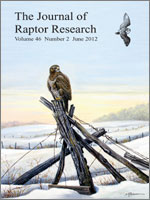Bald Eagles (Haliaeetus leucocephalus) were one of the upper-trophic-level avian predators on the Channel Islands, California, prior to their extirpation by 1960 caused in part by large amounts of DDT discharged into the Southern California Bight. From 2002 to 2006, 61 Bald Eagles were reintroduced onto the northern Channel Islands, as part of a 5-yr feasibility study conducted under the auspices of the Montrose Settlement Restoration Program. In December 2005, a yearling Bald Eagle female was found on Santa Rosa Island with a broken wing and elevated lead levels in her blood of 52.2 ug/dl (0.522 ppm). This incident raised concerns that lead poisoning could be a potential threat to the restoration effort and prompted further investigation. Femurs from five female and two male Bald Eagles reintroduced to the northern Channel Islands were collected postmortem for analyses of lead and other metals. Lead levels detected in femurs of these birds ranged from 0.2 to 55.0 ppm (dry weight). Lead levels in liver were also determined for two of the seven Bald Eagles. Analysis of Bald Eagle movement data from satellite telemetry transmitters suggested that eagles that spent the most time on Santa Rosa Island had the highest lead levels. The results of this study suggested that spent ammunition containing lead found in carrion (offal and entire carcasses) from deer and elk hunting on Santa Rosa Island may have been a primary source of contamination. The on-island hunt program converted to nontoxic bullets in 2007 and ended in late 2011.
How to translate text using browser tools
1 June 2012
Exposure of Bald Eagles to Lead on the Northern Channel Islands, California
Joel E. Pagel,
Peter B. Sharpe,
David K. Garcelon,
Annie E. Little,
Sharon K. Taylor,
Kate R. Faulkner,
Carol S. Gorbics

Journal of Raptor Research
Vol. 46 • No. 2
June 2012
Vol. 46 • No. 2
June 2012
Bald Eagle
California Channel Islands
contaminants
Haliaeetus leucocephalus
lead ammunition
lead exposure
Metal




